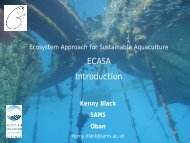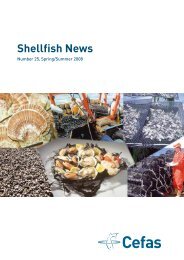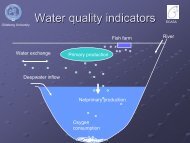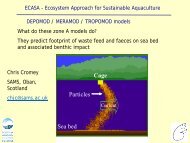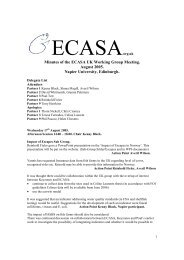carrying capacity models for shellfish - ecasa
carrying capacity models for shellfish - ecasa
carrying capacity models for shellfish - ecasa
- No tags were found...
You also want an ePaper? Increase the reach of your titles
YUMPU automatically turns print PDFs into web optimized ePapers that Google loves.
operations. This is partly because aquaculture, especially the culture of carnivorous fishspecies in netpens, commonly produces elevated nutrient levels and strong organicdeposition in the neighbourhood of culture sites (Cromey et al., 2000). This results fromthe fact that aquaculture operations, especially those in open water net farms, are leakysystems with a considerable proportion of the material added to grow the animals ofinterest ending up in the surrounding environment (Schendel et al., 2004). This additionof organic matter can overwhelm the assimilative <strong>capacity</strong> of the local environment, thussometimes changing the physical, chemical, and biological structure of the bottom.However, high effluent levels are not limited to fish cage farms and increasing evidenceshows that the culture (grow-out) of bivalves may also have considerable influences onthe benthic environment (Kaiser et al., 1998). In short, bivalves growing in suspensionfeed on detritus, phyto- and zooplankton in the water column, using part of what isfiltered <strong>for</strong> growth and consolidating the remaining fraction as either faeces orpseudofaeces, which sinks relatively quickly to the bottom, potentially increasing theaccumulation of organic material in the vicinity of the site. For both types of aquaculture,the “footprint” or areal size of the impact is a function of many factors, including the sizeand age of the farm, the species being cultivated, and local hydrodynamic and naturalbenthic conditions (Black, 2001; Magill et al., 2006).To date, research on the environmental effects of aquaculture has largely focussed onbenthic processes as they relate to increased deposition of organic matter (Carroll et al.,2003). Despite the evidence that aquaculture sites may influence local benthic infaunalcommunities (i.e, altering their structure), little work has addressed issues about theirproductivity and sustainability. Similarly, little research has been directed at examininginteractions between bivalve aquaculture and the abundance and productivity of largebenthic invertebrates, such as crabs and lobster, and fishes (Munday et al., 1994). Thisconcentration on benthic processes also ignores the influence of bivalve culture on watercolumnprocesses and the organisms that live in association with the bivalves growing inculture. Differences on the influence of bivalve culture between benthic and pelagiccomponents may be striking (Tenore and González, 1976). Further, most work to datehas concentrated on near-field effects, ignoring far-field effects. Such effects are rarelydiscussed (but see Davenport et al., 2003; Gibbs, in press) and within those publicationswhich address this issue there is a bias toward “negative” effects, largely ignoringpotentially “positive” ones (see, <strong>for</strong> example, Gibbs, 2004). A more holistic approach isneeded to determine the influence of bivalve aquaculture on the environment and theecological <strong>carrying</strong> <strong>capacity</strong> of the environment <strong>for</strong> bivalve culture.There is much scientific literature showing that the abundance of fish andmacroinvertebrates is greater in areas on or immediately surrounding artificial reefs(structures placed on the bottom of the sea by humans) (Jensen, 2002) and fishaggregation devices (FADs – structures positioned in the water column or at the surfaceof the water) (Castro et al., 2002), relative to areas distant to them. Aquaculture sitesmay function in a manner analogous to these structures (Costa-Pierce and Bridger, 2002;Olin, 2002; Davenport et al., 2003). There are many examples of wild animals benefitingfrom bivalve culture. For example, Tenore et al. (1982) suggested that intensive musselaquaculture in the Ria de Arosa, Spain increases the production of fishes there, althoughthere was no direct evidence given. This was echoed in a study by Tenore and González



